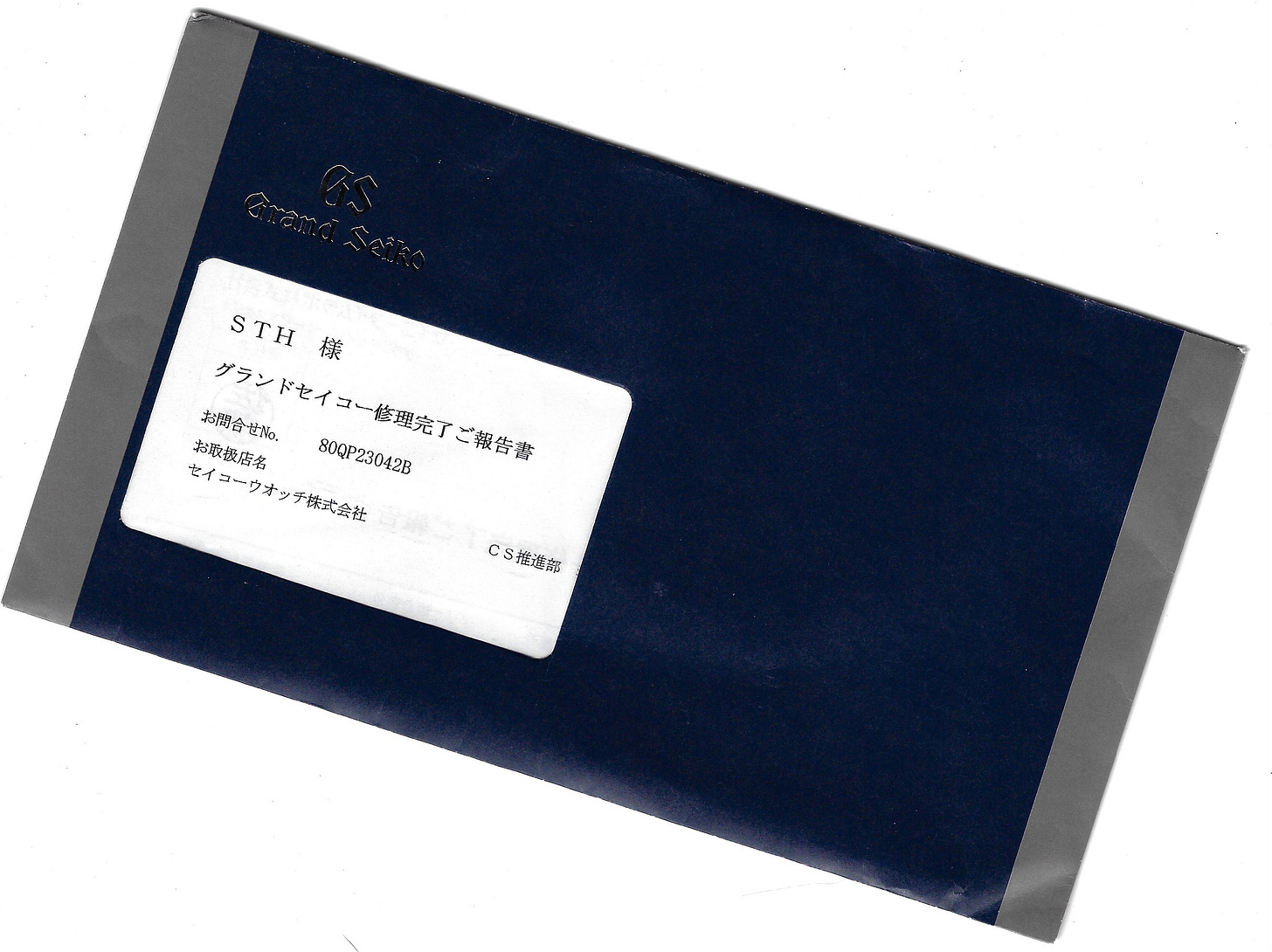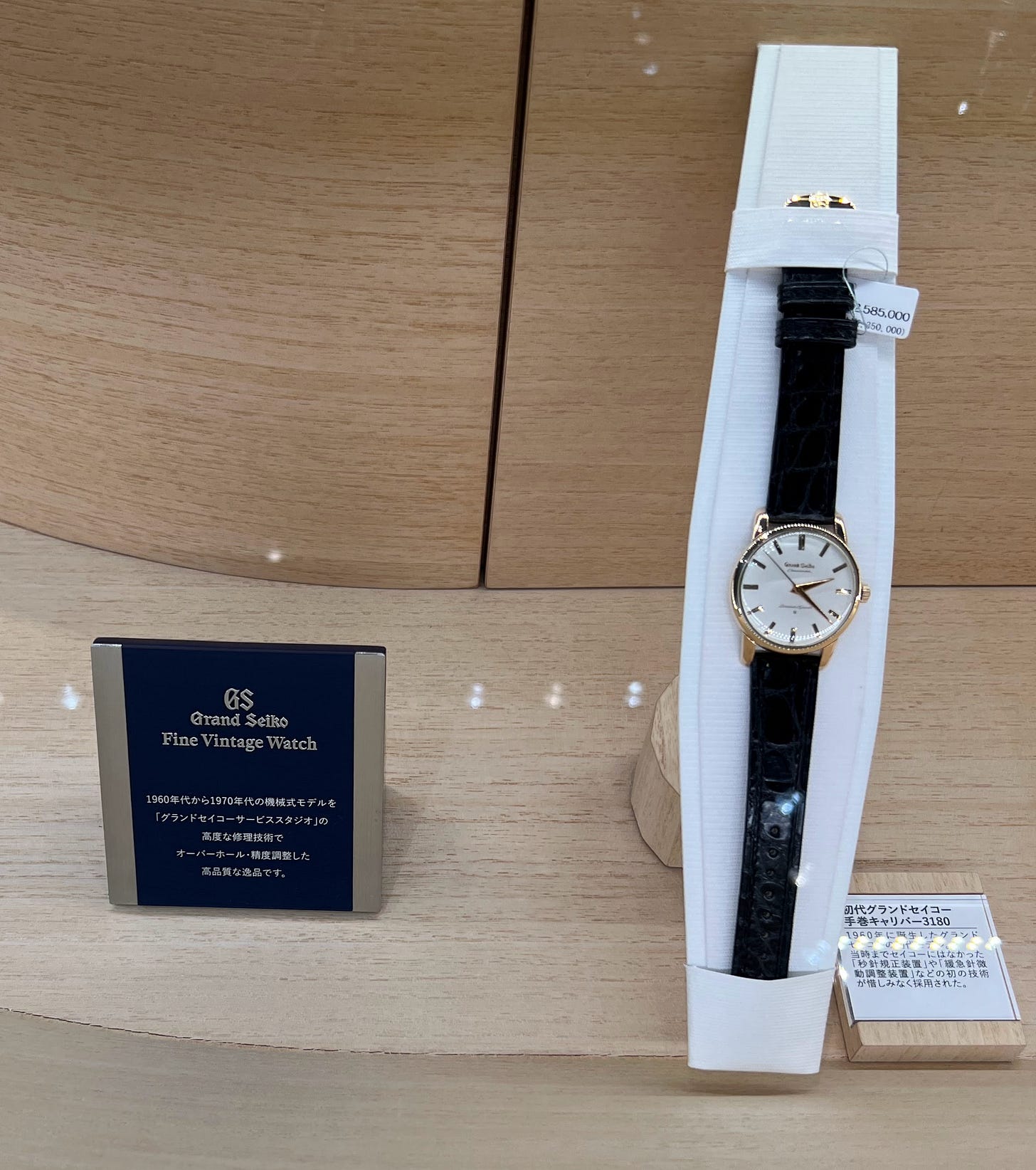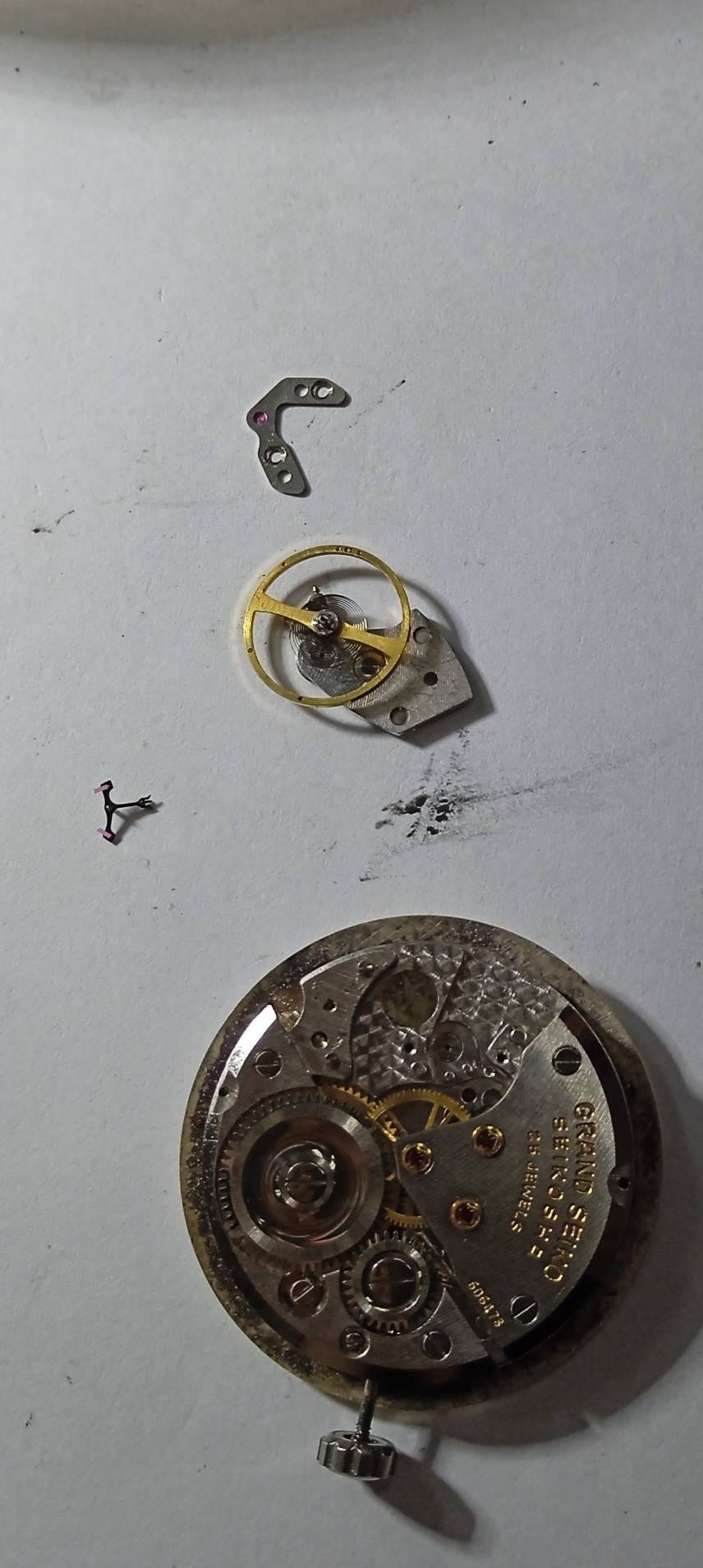Introduction
Those subscribers who are regular readers of my Friday newsletters might have noticed that from time to time, I highlight a listing for a watch that includes official Grand Seiko service papers.
The possibility of having a vintage Grand Seiko serviced back at “the mothership” is something not that widely known in the collecting community - which isn’t that surprising given that I have never seen the existence of this service publicly marketed by Grand Seiko, and only became aware of it myself when I saw auction listings including the service papers.
Naturally for any collector of vintage watches, it can be reassuring to know that the brand themselves are willing to support them by providing a service facility for their old watches.
A few months ago, a listing for an example of the first Grand Seiko turned up on Yahoo Japan that included recent service papers, and I was particularly intrigued by the condition of the case of the watch.
Above is pictured an image from that auction listing showing the watch and the accompanying service papers, and in the photo below, the watch itself.
The thing that really caught my eye was the condition of the case on this watch, and a translation of the service papers confirmed that the case had been repolished during the course of the service.
To polish, or not to polish. That is the question.
Now, it is of course probably an understatement to say that the issue of repolishing the cases of vintage watches is a contentious subject. However, at the end of the day it is entirely the business of the individual who owns their watch as to what they choose to do with it.
Clearly what is important is that should a watch that has been refinished or repolished ever be offered for sale, the seller should be open and honest about the fact.
There’s no question that the holy grail for any vintage Grand Seiko reference is to find a completely untouched “dead stock” example, but sadly you’d probably find it easier to breed a unicorn with a griffin than add something like this to your collection -
In the vast majority of circumstances, personally I would not consider adding a refinished or repolished watch to my collection, but there are a couple of exceptions.
The first exception would be for an example of a very desirable reference, whose case had been poorly refinished already, or was in exceptionally poor condition. In such circumstances, there is a strong argument to be made for sending the watch off to a highly skilled lapinist to work miracles on (I currently have two watches in Kamil’s queue, and cannot recommend his work highly enough, although you do need to be exceptionally patient because it is a very, very long queue!).
The second exception would be for examples of the first Grand Seiko. These of course date from before Takana-san started to introduce his “Grammar of Design” principles, and so the original cases do not benefit from Grand Seiko’s famed “Zaratsu” polishing.
With cases clad in a thick layer of relatively soft 14K gold, and with almost every single example having been around now for six decades or more (next month is the 60th anniversary of the final production of the reference), almost without exception we find these cases to show the scars of time, with the lugs particularly susceptible to dings and scratches.
In addition to the auction listing highlighted above, I had seen first hand another example of “the mothership’s” work on an example of a vintage Grand Seiko, on a visit to the Wako department store in October last year.
So not only were Grand Seiko servicing examples of their first reference for collectors - including restoring the case to very close to original condition - they were also doing so to watches that they would subsequently offer for sale in their flagship outlet. And for those who can’t quite make it out, the price for the watch I handled at Wako - and it should be stressed that this watch has subsequently sold - was over 2.5 million Yen. For a “regular” raised logo dial variant.
Having handled a mint, untouched example of the reference to serve as a baseline comparison to the restored examples, I felt confident enough to send off one of my own watches to Grand Seiko Japan. And what better example to start with than a print logo dialed variant dating from the very first month of production - April 1960?
Servicing a print logo dial Grand Seiko from April 1960
It’s one thing to be armed with the knowledge that Grand Seiko Japan will service watches from the vintage era, but almost everyone reading this newsletter will not be residing in Japan, and you’re probably wondering how on earth do you go about organising the service?
Fortunately, the answer is simple - just do it through your local Grand Seiko boutique. There are many Grand Seiko boutiques around the world now, and I suspect that most readers will be covered already in their own countries. If not, your local Grand Seiko authorised dealer, or Seiko service center should also be able to arrange to have a watch sent back to Japan for service (it might take a little bit of nagging and encouragement to convince them to make the effort, but they should be able to handle the request).
For me, this meant a good excuse to hop on the plane and visit the Grand Seiko Boutique in Bangkok.
I dropped off the watch at the end of April, and made it very clear what I wanted doing, including sharing in emails photographs of the watch that had been listed on Yahoo Japan, along with a “Please, whatever you do, do NOT touch the dial!”.
Whilst I was a little concerned about the language barriers involved along the chain, and that I had no direct contact with Grand Seiko in Japan, the service from both the representatives at the Grand Seiko Boutique, and those at the Bangkok Seiko Service Center was absolutely exemplary, and gave me the confidence that the message would get through to the mothership as to what my expectations were.
I was advised that the process would first involve the watch being sent to Japan, and then Japan would get back to Thailand with a quote, and if I was happy to proceed, the watch would then be serviced.
About six weeks after dropping off the watch, the service cost was confirmed (ouch! - more on this later), and I was advised it would be 8-10 weeks before the watch was back in my hands.
That 8-10 week lead time turned out to be very much on the cautious side, because stepping out from the IMAX premier of the new Mission: Impossible film on July 11th in Bangkok, I discovered that during the course of the movie I had received an email from the local service center to inform me that they had received the watch back from Japan already.
A couple of days later, and I was sat in the boutique, a little trepidatiously it must be said, and the watch was handed over to me.
The results of the service can be seen in the video at the top of the article. I will leave it up to the reader to decide what they think, but personally I’m very happy with the result of the work on the case.
Rather stupidly, I didn’t take a video of the watch prior to dropping it off for a service, so I can’t show you a “before and after”. The case was certainly in better condition than many that I have seen and owned prior to the service, but there is no doubt in my mind that it has been considerably improved following its visit to the spa.
If I were really nit-picking, I would probably suggest that the edge on the lug bevel where it meets the top lug surface is a little softer than it is where it meets the side lug surface, but this may be an illusion because of the side angle being considerably larger (if measured externally) than the top one.
Take a good look at the video, and let me know what you think in the comments.
As to what else was involved in the service, we need to take a look at the service paper itself, and do some translating -
Rather than walk through it all, here’s a screenshot of the Google Translated document -
For those interested in how the watch is performing following the service, I’ve just checked it on a timegrapher (I know it’s not a “proper” test, but it is at least indicative of what to expect) and here are the results -
Costs, and conclusion
I’m sure everyone who has got this far into this article will be interested to know how much the service cost.
I was initially quoted 24,000 Thai Baht + shipping both ways for the cost of the service. The total ended up being a nice round 30,000 Thai Baht, or a little under US $900 (£700, €800, HK$7,000, SG$1,150).
I suspect that there may be a few eyebrows being raised at this point, and mine would be among them, although perhaps I’m coming from a rather privileged position.
I am extremely fortunate that on first moving to Thailand about 5 years ago, I was able to find a wonderful watchmaker in Chiang Mai working at the local Seiko authorized dealer who has been servicing Seikos for more than forty years. Whilst I would never ask him to do any case work, his movement servicing is excellent, and his charges are quite frankly ridiculous. The very first time he serviced a vintage Grand Seiko movement for me, I was charged 500 baht (back then, about $15). I told the manager of the shop that I would be more than happy to pay three times that amount, and that I would continue to bring him watches to service on a regular basis. The next watch I brought in I was charged 1500 baht, and we have had a very happy relationship ever since.
So - to me, 30,000 baht for a movement service and a light polish of a case is a huge amount of money, particularly given this comment on the service paper -
“Please note that the performance may not be maintained during the next maintenance, and the product may be returned without being repaired.”
I find this a rather odd statement - particularly given directly above it is the advice that to ensure long-term use of the watch, GS recommend to have it overhauled once every 3-4 years!
Whether or not this is just the Grand Seiko Service Studio covering themselves, or actually constitutes a genuinely held concern, it is an odd thing to communicate, and I suspect a slight downside to this very remote and disconnected way of doing things. Were I to be in Japan and had dropped the watch off at Wako for example, I’m sure it would be a relatively simple matter to have a more in-depth discussion on this.
As someone who has had “quite a few” vintage Grand Seikos serviced in the process of them either joining my collection or passing through my hands, I have never been in the situation where I needed to inform a collector that perhaps when it came to servicing the watch next time around, nothing could be done. Whenever my watchmaker informs me that a part is beyond repair, I purchase spare parts, or even sacrifice entire movements and watches in order to cannibalise them for the required part, prior to finishing the servicing of the watch and sending it off.
The most recent instance of this was actually on an example of a carved logo dialed first Grand Seiko. The watchmaker asked me to send him another example of the same watch so he could cannibalize it for the parts he needed. I promptly sent him another one, and a few days later received this photo, showing the parts cannibalized for the customer’s watch -
*gulp*
Oh - and the total cost of that service, just 2,000 baht.
Obviously it’s now down to me to find those rather important parts for the movement that was cannibalised (do you notice something rather special in the photo above?), but that’s fine - I’m happy to take the time to do so to bring the donor watch back to life (it’s not as if I have any desire to sell it!).
Whilst I think it is commendable that Grand Seiko in Japan now offer a service capability for the vintage watches, I do think that there is plenty that could be done to improve things, and can’t help thinking that it would a very positive look for the brand were they to invest some funds into being able to have a lot more confidence in the serviced watches that leave their workshop.
However, despite those reservations, I am happy with the outcome of this little “experiment”, and can rest easy that I now have in the collection a very nice example of one of the true vintage Grand Seiko grails. Not only that, but should anything untoward happen to the movement in the future, I know a wonderful old man who will be able to fix it for me - even if it does involve sacrificing another watch to do so!
Please do use the comment section below to share your thoughts on this article, and also to share any experiences you have of getting your vintage Grand Seikos serviced.















Share this post